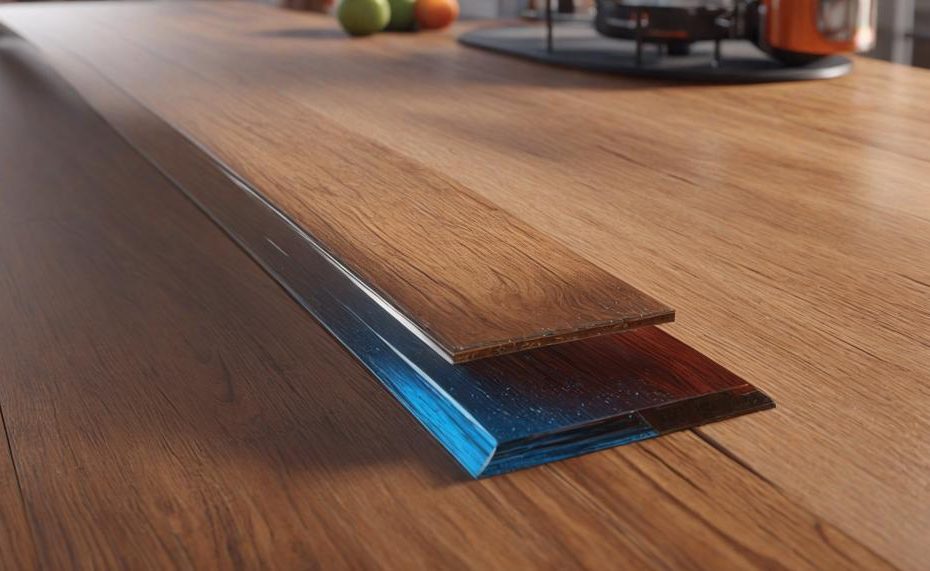Can acrylic be glued to wood? Absolutely. Whether you’re a DIY enthusiast or a professional, bonding acrylic to wood is a straightforward process with the right adhesive. The key lies in understanding which type of glue suits your specific needs.
Here’s a quick rundown:
- Acrylic Polymer Glue: Ideal for hidden areas, providing the strongest bond.
- Multi-Surface Adhesive: Versatile and easy to use, great for various projects.
- Epoxy: Perfect for visible areas, offering a clear and durable finish.
- Cyanoacrylate Glue (Super Glue): Quick and effective for small projects.
Each type of glue interacts differently with wood and acrylic, so choosing the right one ensures a lasting and aesthetically pleasing result. Stick around to discover the nuances of these adhesives and how to make your projects seamless and sturdy.
Table of Contents
Understanding the Materials
When gluing acrylic and wood together, several key differences in their properties affect the bonding process. Here are the crucial distinctions:
| Aspect | Acrylic | Wood |
| Material Composition | Acrylic is a type of plastic, known for its smooth and non-porous surface. | Wood is an organic material, inherently porous and fibrous. |
| Strength | Generally less strong in load-bearing applications compared to wood. | Stronger and more suitable for structural applications. |
| Weather Resistance | Highly resistant to weathering and moisture, making it suitable for outdoor use. | Prone to warping and degradation when exposed to moisture and harsh weather conditions. |
| Environmental Impact | Produced using chemicals and fossil fuels, making it less eco-friendly. | A renewable resource, but its production can still impact the environment through deforestation. |
| Applications | Commonly used in signage, displays, and decorative purposes due to its clarity and smooth finish. | Widely used in construction, furniture-making, and other structural applications. |
Gluing Considerations
To effectively glue acrylic and wood, understanding the types of adhesives suitable for these materials is crucial. The four main types of glue are:
- Acrylic Polymer Glue: This provides the strongest bond but is best used in hidden areas due to its less aesthetic finish.
- Multi-Surface Adhesive: Suitable for various materials but may not offer the strongest bond for acrylic and wood specifically.
- Epoxy: Offers a strong, clear bond, ideal for visible joints. It’s a two-part adhesive that cures to a hard, durable finish.
- Cyanoacrylate Glue (Super Glue): Provides a quick, strong bond but can be brittle and less durable under stress.
Choosing the right adhesive depends on the specific needs of your project, such as the required bond strength, visibility of the glued area, and environmental exposure.
Selecting the Right Adhesive
When selecting an adhesive for gluing acrylic to wood, several crucial factors must be considered to ensure a strong and durable bond.
Factors to Consider:
| Factor | Description | Notes |
| Bond Strength | The adhesive must provide a strong and lasting bond to withstand stress and strain. | Consider adhesives like epoxy or cyanoacrylate for high strength. |
| Compatibility | The adhesive should be compatible with both acrylic and wood without causing damage or discoloration. | Solvent-based adhesives can be suitable, but ensure they don’t react negatively with acrylic. |
| Cure Time | Different adhesives have varying cure times, which can affect the overall project timeline. | Cyanoacrylates cure quickly, while epoxies might take longer. |
| Clarity | For aesthetic purposes, the adhesive should dry clear, especially if the bond is visible. | UV-curing adhesives are known for their clarity and are often used for transparent joints. |
| Application Method | Ease of application is important, particularly for DIY projects or intricate work. | Consider whether the adhesive can be applied with a brush, syringe, or other applicators. |
| Environmental Resistance | The adhesive should withstand environmental factors like moisture, heat, and UV exposure. | Epoxies generally offer good resistance to environmental conditions. |
| Flexibility | The adhesive should accommodate the different expansion rates of acrylic and wood. | Flexible adhesives like certain polyurethane options can be advantageous. |
Additional Considerations:
- Surface Preparation: Properly cleaning and roughening both surfaces before application can enhance the bond strength.
- Testing: Conducting a small test before the final application can help determine the adhesive’s effectiveness for your specific materials.
How to Glue Acrylic to Wood
The best techniques for successfully gluing acrylic to wood involve selecting the right adhesive, preparing the surfaces, and applying the glue correctly.
Choosing the Right Adhesive
| Type of Glue | Best Use | Characteristics |
| Acrylic Polymer | Hidden joints | Strong bond, ideal for hidden areas |
| Epoxy (Two-Part) | Visible joints | Clear finish, very strong |
| Multi-Surface Adhesive | General use | Moderate strength, versatile |
| Cyanoacrylate (Super Glue) | Small projects | Quick setting, less flexibility |
Surface Preparation
- Clean the Surfaces: Both acrylic and wood should be free of dust, oils, and debris. Use isopropyl alcohol to clean the acrylic and a damp cloth for the wood.
- Sanding: Lightly sand the wood to create a better grip for the adhesive. Use fine-grit sandpaper for this task.
- Dry Fit: Ensure that the acrylic piece fits perfectly on the wood before applying any glue.
Application Techniques
- Acrylic Polymer Glue:
- Apply a thin, even layer on the wood surface.
- Press the acrylic onto the wood and clamp it firmly.
- Allow 24-48 hours for the glue to fully cure.
- Two-Part Epoxy:
- Mix the resin and hardener according to the manufacturer’s instructions.
- Apply the mixture to both surfaces.
- Align the acrylic and wood, then clamp securely.
- Let it cure for the recommended time, usually around 24 hours.
- Multi-Surface Adhesive:
- Apply a small amount to both surfaces.
- Press together and hold for a few minutes.
- Clamp if necessary and let cure as per instructions.
- Cyanoacrylate (Super Glue):
- Apply sparingly to one surface.
- Press together immediately.
- Hold in place until the bond sets, which is typically very fast.
How to Stick Acrylic Sheet to Plywood
Acrylic Polymer Glue
Acrylic polymer glue offers the strongest bond when attaching acrylic sheets to plywood. It’s particularly suitable for areas that will be hidden due to its opaque nature.

Two-Part Epoxy
For a clear, strong bond, a two-part epoxy like UltraClear Epoxy Adhesive is ideal. It resists yellowing and provides a durable connection, making it perfect for visible areas.
Multi-Surface Adhesive
Multi-surface adhesives are versatile and convenient for bonding acrylic to plywood. They provide a strong, clear bond but may not be as robust as epoxy.
Cyanoacrylate Glue (Super Glue)
Cyanoacrylate glue, commonly known as super glue, is quick-setting and effective for smaller projects. It’s best for lightweight applications where speed is essential.
Application Steps
| Method | Steps | Tips |
| Acrylic Polymer Glue |
|
Ensure even pressure during curing for best results. |
| Two-Part Epoxy |
|
Work in a well-ventilated area and wear gloves. |
| Multi-Surface Adhesive |
|
Check compatibility with both materials before use. |
| Cyanoacrylate Glue |
|
Use sparingly to avoid excess glue marks. |
For detailed guidance, consult manufacturer instructions and consider the specific requirements of your project.
Can You Use Super Glue on Acrylic to Wood?
The short answer is yes, you can use super glue on acrylic to wood. For optimal results, follow these steps:
- Surface Preparation: Clean both the acrylic and wood surfaces to remove dust, grease, and any other contaminants. Use a soft cloth with isopropyl alcohol for thorough cleaning.
- Roughen Surfaces: Lightly sand the areas to be glued on both materials to create a better grip. Use fine-grit sandpaper, then wipe off the sanding dust.
- Application of Glue: Apply a thin, even layer of super glue to the wood surface. Super glue bonds quickly, so ensure precise application.
- Press and Hold: Immediately press the acrylic onto the wood, aligning them correctly. Hold the pieces firmly together for a few minutes to ensure the glue starts to set.
- Curing Time: Allow the bond to cure for at least 24 hours for maximum strength. Avoid disturbing the glued parts during this period.
- Safety Precautions: Wear gloves to protect your skin from the glue. Ensure good ventilation to avoid inhaling fumes.
How Do You Glue Acrylic at Home?
To successfully glue acrylic to wood at home, follow these steps and use the appropriate materials:
Materials Needed:
- Acrylic adhesive: Choose a suitable adhesive like cyanoacrylate (super glue), solvent-based adhesive, or UV-curing adhesive.
- Sandpaper: Use 100-120 grit sandpaper to roughen the surfaces for better adhesion.
- Cleaner: Ensure surfaces are free from dirt, oils, and debris.
- Clamps or weights: To hold the materials together during the drying process.
Steps:
| Step | Description | Details |
| Prepare the surfaces | Clean and sand the surfaces | Use a cleaner and a lint-free cloth to remove any residue. Sand both surfaces with 100-120 grit sandpaper to ensure a better bond. |
| Apply adhesive | Evenly apply adhesive | Follow the instructions on the adhesive. Apply a thin layer on one surface using a brush or roller for solvent-based adhesives. |
| Press surfaces together | Align and secure the materials | Place the acrylic and wood surfaces together. Use clamps or weights to hold them in place, ensuring even pressure across the surface. |
| Let it dry | Allow sufficient drying time | Refer to the adhesive instructions for drying time. Ensure the bond is fully set before removing clamps or weights. |
| Remove clamps or weights | Check the bond | After the recommended drying time, carefully remove the clamps or weights. The bond should be strong and secure. |
Conclusion
Absolutely, gluing acrylic to wood is a practical and straightforward task, whether you’re a DIY hobbyist or a professional craftsman.
The success of this process hinges on selecting the right adhesive tailored to your project’s specific requirements. Here’s a concise guide to help you navigate your options:
- Acrylic Polymer Glue: Ideal for concealed joints, this adhesive offers unparalleled strength, making it perfect for projects where aesthetics are not a priority.
- Multi-Surface Adhesive: Versatile and user-friendly, this glue is suitable for a variety of applications, though it may not always provide the strongest bond between acrylic and wood.
- Epoxy: This two-part adhesive is excellent for visible joints, providing a strong, clear bond that cures to a durable finish.
- Cyanoacrylate Glue (Super Glue): Quick and effective for small projects, this adhesive forms a strong bond but can be brittle under stress.
Each adhesive interacts differently with acrylic and wood due to their distinct properties. Acrylic is a smooth, non-porous plastic, while wood is organic and porous, influencing how adhesives adhere. Consider factors like bond strength, compatibility, and cure time to ensure a successful bond.






